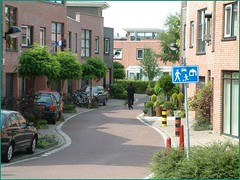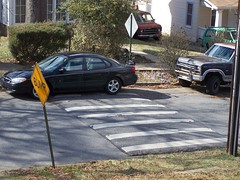Pavement engineering vs. pimples on the streets

Woonerf. Photo source unknown.
I "love" ANC6A. I think they are one of the best ANCs in DC. However, for the most part the neighborhood still thinks about traffic "calming" rather than a more fundamental approach (as advocated in the previous entry): that neighborhood streets should be built using neighborhood-appropriate materials, rather than to standard technologies capable of allowing cars to drive in excess of 50 mph.
ANC6A communicated to the DC Dept. of Transportation, asking for action on 14 outstanding matters. On the list, 11 have to do with traffic calming (and angle parking is a good tactic). But putting a speed hump on a street doesn't get to the real issue:
1. Transportation audit to implement traffic calming measures for 1300 block of G Street, NE submitted November 2008.
2. Transportation audit to implement traffic calming measures between the 800 and 1000 blocks of G Street, NE submitted November 2008.
3. Transportation audit to implement traffic calming measures between the 600 block of 9th Street, NE submitted November 2008.
4. Transportation audit for 500, 600, 700, 800, and 900 blocks of 13th Street, NE submitted March 2008.
5. Transportation audit for 800 and 900 blocks of 12th Street, NE submitted March 2008.
6. Speed hump request for the 1300 block of Emerald Street, NE submitted June 2008.
7. Speed hump request for the 1200, 1300, and 1400 blocks of E Street, NE submitted August 2008.
8. Request for analysis of angle parking on the 500 block of Tennessee Avenue, NE submitted August 2008.
9. Request for transportation audit of 1600 Rosedale Street, NE submitted October 2007 and resubmitted May 2008.
10. Request for review of paving in public space at 901-903 D Street, NE submitted January 2009.
11. ANC request for pedestrian safety improvements at uncontrolled pedestrian crosswalks across Maryland Avenue at 10th Street, NE submitted March 2008.
Belgian block for neighborhood streets!
This many year old report from the UK, "Living Spaces: Cleaner, Safer, Greener" is very good, and opens your eyes to rethinking streets and places.
Also see "The Woonerf Deficit" from the New York Observer. From "Taking Back the Streets" in the New York Times:
The Woonerf
“Twenty or thirty years ago we had two different types of streets to choose from,” said Jan Gehl, an urban planner from Copenhagen who is advising the Transportation Department on ways to revamp New York’s public spaces. “One was the traffic street and the other was the pedestrian mall. Now we have about eight streets to choose from.”
One such street is the woonerf. Pioneered in the Netherlands — the word roughly translates as “living street” — the woonerf erases the boundary between sidewalk and street to give pedestrians the same clout as cars. Elements like traffic lights, stop signs, lane markings and crossing signals are removed, while the level of the street is raised to the same height as the sidewalk.
A woonerf, which is surfaced with paving blocks to signal a pedestrian-priority zone, is, in effect, an outdoor living room, with furniture to encourage the social use of the street. Surprisingly, it results in drastically slower traffic, since the woonerf is a people-first zone and cars enter it more warily. “The idea is that people shall look each other in the eye and maneuver in respect of each other,” Mr. Gehl said.

Speed bump (in Mount Rainier, Maryland).
Labels: car culture and automobility, transportation planning, urban design/placemaking



2 Comments:
It has been very useful, I was looking for something similar,greetings and thanks.
nice information.Have a medicine website. there is a medicine that seems to work, please check out website.Take this medicne as advised by the doctor that are easily available at the online medicine store in USA.
Post a Comment
<< Home